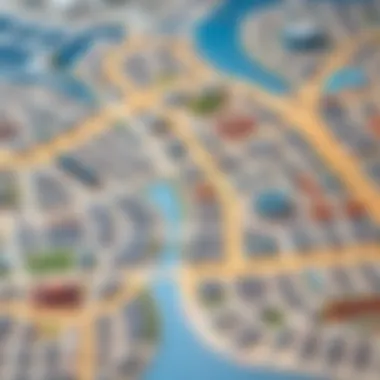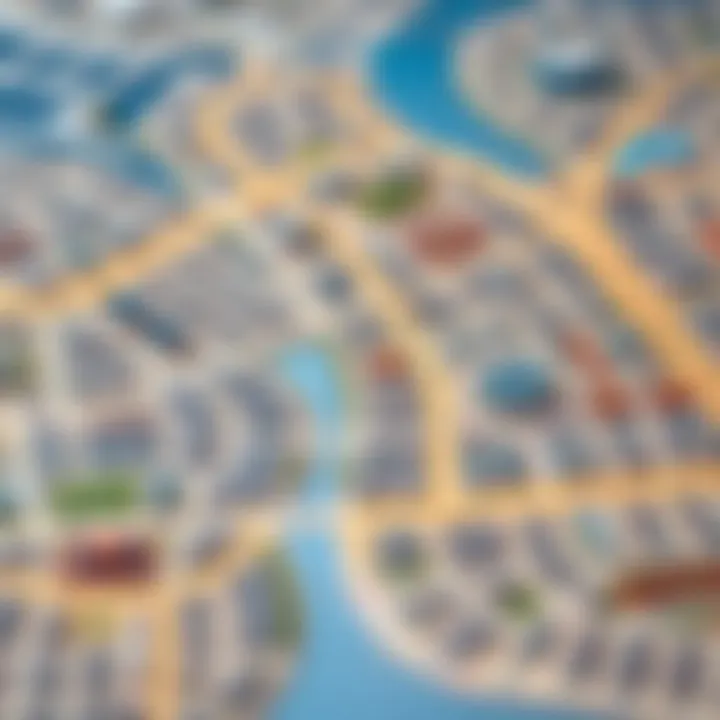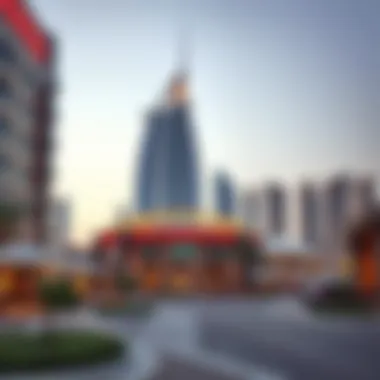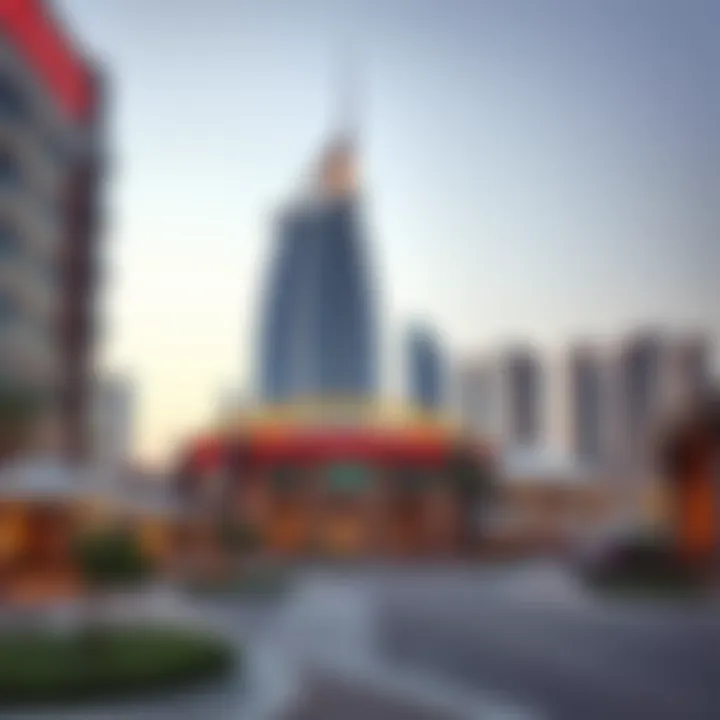Mastering the Dubai International City Map for Investors


Intro
Navigating a map often reveals much more than mere topography; it encapsulates layers of history, community dynamics, and economic potential. When looking at the Dubai International City map, one finds an array of unique zones filled with possibilities. This area, known for its culturally-inspired architecture and residential offerings, is a mosaic of distinct styles representing various global influences.
Investors and homeowners alike must grasp the layout and key features that define this vibrant community. The importance of understanding the map cannot be overstated, especially in a rapidly evolving real estate market like Dubai's. As we delve into the nuances of the Dubai International City map, we will unpack insights and practical tips beneficial to both seasoned investors and first-time buyers.
Understanding Dubai International City
Understanding Dubai International City is key for anyone who aims to navigate the real estate landscape of this vibrant community. This complex is not merely a collection of buildings and homes; it’s an intricate tapestry of cultures and lifestyles, stitched together by the ambition and dreams of its diverse residents. This article sheds light on the significance of this community, places where investment opportunities abound, and provides guidance for both current residents and potential investors.
Prologue to the Community
Dubai International City stands as a microcosm of global cultures, representing various nations through its themed clusters. Each cluster prides itself on unique architecture and communal spirit reflective of its native land. For example, the China Town cluster replicates iconic designs found in Shanghai, while the France Cluster showcases the rustic charm of ancient French towns. Understanding this community is crucial for investors looking to tap into the diverse demographics that reside here.
The area itself is designed to be self-sufficient, offering a blend of residential areas, commercial spaces, and recreational facilities. This self-sustainability appeals to families and young professionals, making it a prime locale for real estate investments.
Historical Overview
Dubai International City has a history as rich as the emirate itself. Established in the early 2000s, the development was envisioned to attract expatriates from around the globe, transforming Dubai into a melting pot of cultures. The initial concept was to create not just housing but a community where people could live and interact, regardless of their backgrounds.
Over the years, the area has grown tremendously, with infrastructure improvements and amenities added at a rapid pace. Notably, this has included schools, parks, and shopping centers—all integral to modern living. The evolution of Dubai International City exemplifies the broader changes in Dubai, reflecting its aspirations to become a global hub.
Map Overview and Significance
The map of Dubai International City is more than a tool; it is a guiding star for both old and new residents alike. Spanning a vast area, the layout consists of various clusters, each distinctly marked and easy to navigate. This visual representation serves multiple purposes—helping newcomers find their way around, enabling investors to evaluate property locations, and assisting residents in locating nearby amenities easily.
Understanding the map's significance is paramount. It highlights the accessibility of the area; for instance, the well-defined major roadways leading to the wider Dubai area, including proximity to the Dubai International Airport. Moreover, recognizing the different zones allows potential investors to strategize where to channel their investment based on market trends and demand.
As all these details come together, they reveal why Dubai International City is not just a residential area but an inviting community offering a range of opportunities for living and investing.
"Dubai International City is a canvas of cultures—every street tells a story, and every corner invites you to explore something new."
This comprehensive understanding of Dubai International City will help to enrich the reader's insights as we delve further into the specific areas and components of the map.
Detailed Map Layout
In exploring Dubai International City, one must first grasp the significance of the detailed map layout. It's not just a guide—it's a key to understanding the broader picture of this diverse community. The intricate layout of zones, residential areas, and commercial spaces is designed to facilitate not just navigation, but also a type of spatial awareness that can benefit both residents and investors alike.
When assessing investment opportunities, potential buyers need to be aware of how each area connects and the amenities available within proximity. The map essentially serves as a blueprint for opportunity, allowing individuals to assess which zones align with their lifestyle or investment goals. Each cluster offers something unique, from cultural insights to practical conveniences, making the map layout an essential tool for anyone looking to immerse themselves in the community.
Key Zones within International City
China Town
China Town is a vibrant hub that mirrors the rich culture of its namesake, characterized by unmistakable architecture and culinary delights. This cluster stands out for its lively atmosphere, where traditional Chinese shops mingle with eateries, creating a bustling marketplace feel.
It’s a popular choice among investors thanks to its cultural significance and potential for high foot traffic. The unique feature of China Town lies in its authentic community events and festivals, drawing residents and visitors alike. However, one might find an overwhelming crowd during peak hours, which could be a downside for those seeking quieter moments.
Russia Cluster
Next up is the Russia Cluster, embodying a chic European aesthetic that has attracted a significant expatriate population. This area is highlighted by its picturesque architecture and a strong sense of community among its residents.
For investors, the Russia Cluster is advantageous due to its dynamic market for rental properties, appealing to professionals and families alike. Yet, one must note that the high demand can lead to competitive pricing, which may dissuade entry-level investors.
Spain Cluster
Spain Cluster radiates a warm Mediterranean vibe, adorned with colorful facades that create an inviting atmosphere. It serves as a hotspot for families looking for a friendly neighborhood, equipped with ample parks and community spaces.


This area is beneficial due to its blend of residential comfort and localized amenities. Unique features include family-friendly activities and a community spirit that often hosts events for its residents. On the downside, its rising popularity can lead to increased noise levels and limited parking spaces, which is worth considering.
France Cluster
The France Cluster evokes a distinct Parisian charm. With tree-lined streets and cozy cafes, it appeals to those who appreciate the finer things in life. This cluster is noted for its elegant residences and art-inspired lifestyle, making it a sought-after destination.
For investors, the France Cluster presents opportunities in premium real estate, with properties that often attract a wealthier clientele. However, this comes with higher initial investment costs, which could be a barrier for some.
Algeria Cluster
Lastly, the Algeria Cluster offers a unique cultural experience with its focus on Arabic architecture and community life. It’s recognized for its community markets and cultural celebrations that highlight its heritage.
This cluster is appealing for those seeking a culturally rich environment, making it a favorable choice for families and expatriates looking for authenticity. However, prospective investors may want to consider that this area's growth might be slower compared to its more modern counterparts, possibly affecting short-term investment returns.
Residential Areas and Amenities
Parks and Recreation
Parks and recreation areas in Dubai International City contribute significantly to the overall quality of life. These green spaces not only provide a sanctuary amidst the urban hustle but also promote community wellness through recreational activities. Families often lean toward areas with ample parkland, making access to such amenities a sweet spot for property investors. Unique features like outdoor gyms and designated play areas for children are key attractions, although one may encounter restricted access during peak hours due to popularity.
Shopping Centers
When it comes to shopping centers, International City offers a mix of local and global brands that cater to diverse tastes. The malls serve as community hubs by providing not just shopping, but dining options and entertainment—to many, they are the heart of daily life. Their significance in the investment equation lies in their ability to drive traffic to surrounding businesses. However, shoppers should be aware that peak shopping times can lead to crowded environments, affecting the overall experience.
Schools and Healthcare
The quality of schools and healthcare facilities is a fundamental consideration for families relocating to Dubai International City. Access to well-rated schools is crucial for young families, as it impacts property desirability. The presence of reputable healthcare facilities enhances the local appeal, especially for long-term residents. Unique advantages here include proximity to educational institutions with diverse curriculums and medical facilities offering specialized care. Yet, families should keep in mind that areas with high demand may see longer commutes to the nearest institutions during peak hours.
Commercial Spaces
Retail Outlets
Retail outlets in the International City present a blend of local and international brands, offering a diverse shopping experience. Their role goes beyond mere shopping; they create valuable economic opportunities for entrepreneurs. The appeal for investors lies in the high foot traffic and community engagement these outlets provide. Unique aspects such as dedicated events and sales promotions can draw more customers, although one must be mindful of the competitive landscape affecting small businesses.
Office Spaces
The rise of office spaces in Dubai International City also reflects on the economic landscape. With well-planned layouts, these spaces cater to businesses looking for affordable yet strategic locations. The key aspect of these office spaces is their modernity and accessibility to both clients and employees. This can be enticing for startups seeking cost-effective solutions. However, rapidly growing competition may contribute to fluctuating rental rates, which potential renters need to consider.
Hospitality Services
Hospitality services in this area have blossomed, with various hotels and lodges catering to diverse visitors. Their significance lies in contributing to the local economy while also providing necessary accommodations for tourists and business travelers. The unique feature here is the availability of themed hotels and specialized services aimed at enhancing guest experience. However, market volatility and seasonality can pose challenges for investors within this sector, affecting occupancy rates throughout the year.
Navigating the Community
Understanding how to navigate Dubai International City is an essential part of grasping the very pulse of this vibrant community. The sheer amount of diversity within the area brings about an exciting yet challenging task for new residents and visitors. Having the right knowledge of transportation options, connectivity, and navigational helps is crucial for anyone looking to thrive here, especially when settling in or making investment decisions.
Public Transportation Options
Bus Services
The bus services in Dubai International City play a pivotal role in facilitating easy movement for residents and visitors alike. Operated by the Roads and Transport Authority (RTA), these buses are quite cheap and connect the community to Dubai's metro stations and various key locations throughout the city. One of the standout features of these services is the extensive network they offer; there are numerous routes that span throughout the International City, making it simpler to access malls, parks, or workplaces. For those on a budget, this option is extremely beneficial, though it's worth noting that bus frequencies can vary, leading to potential waiting times during off-peak hours.
Metro Access
Metro access is another noteworthy aspect of transportation here. The nearest metro station, Dubai International City Metro Station, provides a direct line into the heart of Dubai, suited for individuals commuting to job hubs or popular city attractions. Men, women, and their families can enjoy this smooth ride while dodging the usual traffic. Unique to the metro line is the Card system that allows for swift payment options making every journey hassle-free. However, as with any system, peak hour congestion can be a drawback, emphasizing the importance of timing when planning trips.
Taxi Services
Taxi services have become increasingly popular for many in Dubai International City, especially for those who prefer door-to-door convenience. With numerous companies providing ride-hailing, the distinctive characteristics of these taxis, such as availability at almost all hours and the option to book via mobile apps, make them a favored choice. It's particularly appealing during the hot summer months when the thought of walking outside is less than inviting. The downside however is cost; taxis can add up quickly, which may deter extended use for those mindful of budget constraints.


Accessibility and Connectivity
Major Roadways
The major roadways surrounding Dubai International City, notably Al Ain Road and Sheikh Mohammed Bin Zayed Road, are fundamental to the community’s accessibility. These roads connect inhabitants to neighboring emirates and the bustling Dubai city center. A key characteristic is their expansive layout, enabling smooth driving in and out of the area. For those who prefer to travel by car, this connectivity is crucial for reducing travel times. On the contrary, heavy traffic during rush hours can pose a challenge, making the commute a bit of a juggling act.
Proximity to Airport
Being located relatively close to Dubai International Airport adds another layer of convenience for residents and investors. Just a short drive away, the airport provides easy travel options for both business and leisure. This characteristic makes the community particularly attractive to expatriates who often have international commitments. However, a consideration for some may be the noise pollution that accompanies such proximity, especially during peak flight times.
Nearby Communities
Dubai International City boasts its proximity to several neighboring communities like Muhaisnah and Al Warqa. These nearby locales create a sense of belonging and contribute to a broader range of amenities available for residents. The ability to explore additional dining options, entertainment venues, and shopping landscapes nearby enhances overall living experience. The downside is that while exploring these neighboring communities is essential, it can also lead to the feeling of being overwhelmed due to the sheer diversity in offerings and lifestyles.
Navigational Tips for New Residents
Understanding Street Names
For newcomers, understanding the street names can initially feel perplexing, as naming conventions often reflect geographical or cultural contexts. Streets in Dubai International City are structured with a methodical logic, categorized by sectors, which means new residents need to familiarize themselves with the layout. The advantage here is that once learned, navigating becomes straightforward. However, initial confusion about street numbers or directions can be a little frustrating, primarily due to the rapid expansion of the area.
Utilizing GPS and Map Apps
Leveraging GPS and map applications such as Google Maps or Waze presents a practical solution for navigating complex streets. These apps provide real-time traffic updates, alternative routes, and estimated journey times, making them indispensable for both newcomers and long-time residents. Their user-friendly interface allows one to easily locate essential services nearby. Nevertheless, reliance on technology can be a double-edged sword; battery drain or lack of signal in certain spots may unexpectedly disrupt navigation.
Local Landmarks for Orientation
Lastly, using local landmarks serves as an excellent guide for orientation. Familiarizing oneself with notable institutions, such as the Dragon Mart or the various cultural clusters can tremendously help residents situate themselves. These landmarks often stand out and become instant points of reference when directing others or finding one's way. However, it requires an initial effort to memorize the key sights, which integrating them deeply into daily routines can change the gears for seamless navigation.
Key Takeaway: Understanding the transportation and navigation landscapes in Dubai International City is a game-changer for both residents and investors. Grasping the transportation landscape ushers in easier living as one establishes themselves in this remarkable community.
Investment Opportunities
Investment opportunities in Dubai International City are truly worth examining, especially for those looking to capitalize on a booming real estate market. Understanding this segment is crucial for investors who wish to navigate the possibilities and complexities inherent in this sprawling community. With a blend of cultural diversity and numerous amenities, the area presents a compelling case for those ready to make their mark.
Real Estate Market Analysis
Current Trends
Current trends in the international property market showcase a noticeable shift towards affordable housing. In Dubai International City, the allure rests in its vibrant culture and dated styles, making it a hotspot for buyers on a budget. The demand is steadily increasing, partly due to the attractive pricing and increasing population, which seeks more affordable living options. One unique feature is its appeal to expatriates, as many prefer neighborhoods that reflect their cultural backgrounds, making this community a melting pot of tastes and preferences.
A beneficial aspect of investing in this region is the assurance of steady capital appreciation. Given its future potential, investors who enter the market today could reap significant rewards down the line. However, one downside includes potential oversaturation, leading to increased competition among investors.
Price Ranges
When delving into price ranges, an investor must consider both the diversity of options and accessibility. Properties in Dubai International City vary broadly, appealing to both low and high-end investors. Condominiums and studio apartments can be found at prices that range from moderate to fairly affordable, impacting overall desirability.
A key characteristic of this community is that it caters to a wide demographic, allowing various price points to flourish. However, prospective buyers should remain cautious about fluctuations dependent on economic climates. One distinct advantage is that these accessible price points attract younger professionals and expatriates looking for proximity to the city center without breaking the bank.
Future Projections
Future projections for Dubai International City are glowing, with the market expected to continue its upward trajectory. Industry experts suggest that the developments on the horizon will offer new conveniences and greater infrastructural support, enhancing the overall living experience.
Investing now could yield excellent returns as the area becomes even more developed. A unique feature is the anticipated rise in rental rates that is likely, given the projected influx of foreign investments and projects being set in motion. Nonetheless, investors should be aware of potential risks if the market changes unexpectedly.
Potential Returns on Investment
Rental Yields


The area boasts attractive rental yields compared to other parts of Dubai. Investors typically find promising returns, mainly due to the high demand for rental properties from expatriates and working professionals looking for housing close to their workplaces.
A distinct characteristic is the relatively low initial capital needed, allowing investors to acquire properties with lesser financial burden yet reap decent returns. However, it’s essential to acknowledge the price fluctuations that could impact rental rates significantly. That being said, well-managed properties can potentially yield higher than average returns.
Market Demand Factors
Market demand factors play a significant role in influencing what an investor can expect in returns. For Dubai International City, the key demand lies primarily with the expatriate population, who look for affordable yet quality housing. Many buyers are also interested in shorter commutes, which includes the area’s proximity to the downtown core.
The high demand derives its benefits from a diverse tenant market, making it a favorable choice for landlords. Any downturn in this demand could affect rental prices negatively, thus it pays to stay informed about demographics that are likely to rent.
Comparative Analysis with Other Areas
A comparative analysis with other regions reveals that Dubai International City often stands out due to its pricing and amenities. While other, more premium areas boast exquisite facilities, they do so at a significantly higher cost. Here, buyers can often strike a balance, enjoying an attractive community without exorbitant prices.
What makes this area appealing is the unique combination of cultural diversity and affordability. However, the downside lies in the potential limits of appreciation compared to more developed neighborhoods.
Legal Considerations for Investors
Property Ownership Regulations
Understanding property ownership regulations in Dubai International City is essential for any prospective buyer. Buyers should be aware that while freehold properties exist, certain areas remain designated for leasehold agreements only.
This characteristic of mixed regulations can be puzzling for new investors, but it also opens doors to a variety of buying options. Investors should familiarize themselves with these norms to navigate their choices effectively. On the flip side, failure to grasp these legalities could lead to detrimental financial consequences.
Visa Options for Buyers
Visa options for buyers often come into play when considering competing in the Dubai property market. Expat buyers looking at purchasing properties may find themselves eligible for various residency visa options, mostly linked to property investments.
A notable benefit is that investors can secure residency through ownership of certain types of properties. This unique aspect can further entice potential buyers looking for long-term stays or investments. However, the procedures can be intricate, requiring careful attention to detail.
Tax Implications
Tax implications represent another crucial aspect of investing in Dubai International City. The region famously offers advantageous tax structures which are very appealing to foreign investors. Key factors to consider include exemptions on capital gains tax and flat property tax rates.
The distinct advantage here is the overall tax-friendly environment, promoting greater initiatives for investment. However, understanding the nuances of these tax regulations is vital in ensuring compliance and maximizing one’s investment.
As investments in Dubai International City continue to gather momentum, understanding these various elements can significantly enhance decision-making for investors looking to make the most of their opportunities.
Closure and Future Outlook
The Dubai International City represents a dynamic fusion of culture, architecture, and business potential in one of the world’s most vibrant cities. Navigating its complexities, from understanding its layout to recognizing investment opportunities, is crucial for anyone looking to engage with this community, whether they are investors, homeowners, or real estate professionals.
This article has laid out the significant aspects of navigating the map of International City. From analyzing the various clusters that highlight its cultural diversity to the practicalities of residential living, the content discussed packs a powerful punch. It aids in demystifying the challenges of finding your footing within this sprawling neighborhood. More importantly, it delineates pathways to success for property investors. It’s essential to synthesize key insights, allowing potential stakeholders to grapple with what makes International City an appealing venture.
"Understanding the layout and the dynamics of a community can unlock doors to lucrative investments and enhance residential satisfaction."
Delving into future developments within International City, it is clear that continued growth is anticipated. The real estate market here is not just stable; it is progressing with various projects aimed at increasing attractiveness and livability. New amenities and enhanced infrastructures are in the pipeline, which stands to elevate property values and quality of life. Moreover, as Dubai evolves into a global hub, International City is positioned to seize opportunities that come with that evolution. Those who stay informed about upcoming initiatives within the community can leverage these growth prospects to ride the wave of rising demand.
In sum, understanding the intricacies of the Dubai International City map—alongside acting on the insights gleaned from this guide—opens the door to not just successful living, but also fruitful investments. The future promises to be as vibrant as the city itself, brimming with possibilities for those who dare to engage with this remarkable community.
Summarizing Key Insights
The map of Dubai International City is more than a mere visual representation. It's a vital tool that encapsulates a world of opportunities vital for investors and residents alike. Some key points to reflect on are:
- The various cultural clusters, each offering unique lifestyles and investment prospects.
- The strategic location, providing easy access to major roadways and public transport that link International City to wider Dubai.
- An overview of residential amenities including parks, schools, and leisure facilities which enhance daily living standards.
- Significant commercial opportunities that cater to both retailers and entrepreneurs, fostering a thriving economy.
Every informed decision made here can guide parties towards optimizing their investments or residential experiences. It’s a blend of culture, community, and commerce that opens a realm of potential.
Future Developments in International City
Looking ahead, the future of International City is certainly promising. Various projects aimed at enhancing infrastructure and community services are underway.
- Urban development projects slated for completion over the next few years aim to introduce state-of-the-art facilities, making daily life more convenient and enjoyable.
- New housing options are expected to include luxury segments, appealing to a broader demographic and creating a rise in property demand.
- Improvements in transportation networks will further connect International City to other key areas, aiming to reduce commute times for residents.
- Enhanced community engagement initiatives could lead to a strengthened sense of belonging among the diverse population.
As these projects materialize, they will likely boost property values and deliver returns worth consideration for those eyeing investment opportunities. The trajectory of Dubai International City suggests a future of prosperity and growth, making it an enticing locale for stakeholders who wish to be part of its evolution.











